Remembering World War I
On April 6, 1917 the United States entered World War I, then known as the Great War. A century later, objects in Special Collections reveal memories of Americans’ lives at wartime. Among the variety of materials available for research are a collection of Red Cross posters, a veteran’s scrapbook, and a nurse’s correspondence with loved ones.
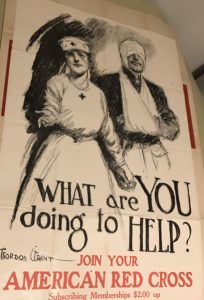
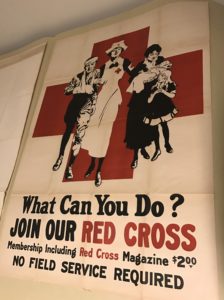
The Red Cross was a vital source of aid and relief both at home and overseas during World War I, providing food, comfort items, and medical care to American and Allied soldiers and their families. In fact, by the end of the war, "nearly one-third of the U.S. population was either a donor to the Red Cross or serving as a volunteer" (American National Red Cross, "World War I and the American Red Cross," http://www.redcross.org/about-us/history/red-cross-american-history/WWI).
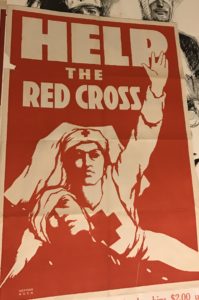
The posters the Red Cross published were pivotal visual tools for soliciting participation in the war effort: "Mass produced, full-color, large-format war posters….were both signs and instruments of two modern innovations in warfare—the military deployment of modern technology and the development of the home front….In addition to being sent to the front, they reached mass numbers of people in every combatant nation, serving to unite diverse populations as simultaneous viewers of the same images and to bring them closer, in an imaginary yet powerful way, to the war. Posters nationalized, mobilized, and modernized civilian populations….It was in part by looking at posters that citizens learned to see themselves as members of the home front" (Pearl James. Picture This: World War I Posters and Visual Culture. Lincoln: U of Nebraska Press, 2009, 2).
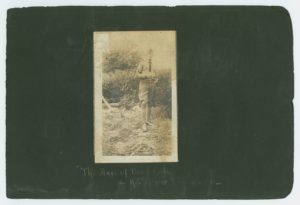

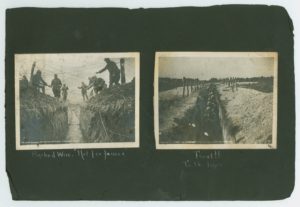
|
The pages of this unbound scrapbook contain photographs and an assortment of ephemera belonging to a member of the 78th Infantry Division of the U.S. Army, identified only as “Emmet” (Mss. Acc. 2009.309). The scrapbook preserves memories from his service, beginning with his departure from New York on May 19, 1918 and concluding with his discharge on May 29, 1919. Included among the pages are hand-written schedules, propaganda dropped from planes, and photographs of cities in destruction, military equipment, and soldiers on the battlefield. |
Clara Louise Walde Lawrence was a nurse whose correspondence relates largely to her career before, during, and after World War I. She wrote letters to her parents, sharing details of her experiences abroad during wartime. She particularly notes illnesses suffered by the soldiers, accounts of the condition of various cities in war-torn Europe, and rumors of the date for her homecoming. Interspersed with her letters home are exchanges with her beau, (and later husband) Sgt. Otto Lawrence.
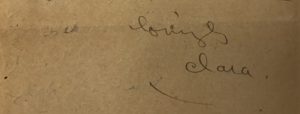
In the letter to her parents at right, dated March 8, 1919, Clara writes:

"Only yesterday I wrote you all a long letter – so will add only a few lines here saying that I hope you enjoy these books, also the map of Rhein which I know will interest you and Dad. Perhaps you can find many(?) places that might interest you that you know about. In this envelope I am sending a snap shot of my dear boy [Otto Lawrence] to realy not as good one as it was his first days out of bed taken on the Ward with some of the other nurses from Base Hosp. No 1. I have better one’s only this was among them pasted in my book of pictures and as it came off the easiest by wetting it. I am sending it to give you an idea of what a nice chap he is I know you will all like him. I also enclosed a negative of my self taken on balcony of my ward early last August, but I am much thinner at present….Have them printed and save them all for me. I just received a telegram dated Jan 31 from my boy on noon mail stating he was leaving “Bordeaux” the next day for good old U.S. it sure made me very lonesome and more home sick than ever, but I don’t think it will be a great while before we will all follow. I am looking for a telegram from New York on his arrival in port, surely that will be some time after this one coming at this late date….Please write soon. Lovingly, Clara."
Also included among Clara’s memorabilia are two photograph albums—perhaps one of them the “book of pictures” she mentions in the letter—that document her experiences.
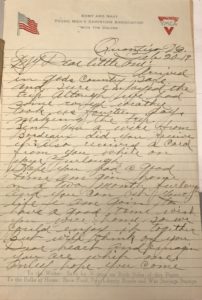
The stationery on which Otto Lawrence wrote this letter (left) to Clara includes a plea “To the Writer: Save by Writing on Both Sides of this Paper, / To the Folks at Home: Save Food, Buy Liberty Bonds and War Savings Stamps.” Even simple tasks like reading and writing letters presented reminders of opportunities for participating in the war; and organizations like the Army and Navy YMCA—who published the stationery Otto used—took those opportunities to encourage support.
*Be sure to stop by the main entrance of Swem Library to see SCRC's display of WWI materials! It will be up through April 23.*

